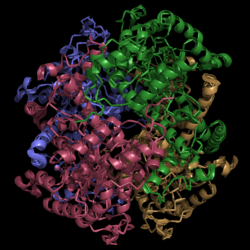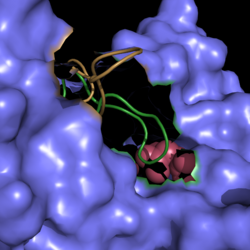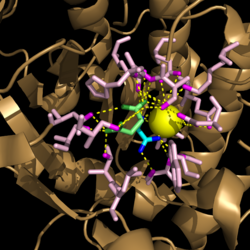Sandbox Reserved 1058
From Proteopedia
(Difference between revisions)
| Line 55: | Line 55: | ||
''Mycobacterium tuberculosis'' is a respiratory infection that causes numerous fatalities throughout the world. It lives in organisms and feeds off of host cells, which indicate a variety of lipases exist within ''M. tuberculosis''. Current drugs that are on the market now target a small number of bacterial processes like cell wall formation and chromosomal replication. Although several antibiotics exist, all of them target these same mechanisms of inhibition. These commonalities have led to the prevalence of different multi-drug resistant (MDR) tuberculosis strains. Due to the high level of resistance, finding a lasting treatment for MDR TB infections has become very problematic. Studies into new mechanisms of inhibition will be crucial to prevent widespread outbreaks. | ''Mycobacterium tuberculosis'' is a respiratory infection that causes numerous fatalities throughout the world. It lives in organisms and feeds off of host cells, which indicate a variety of lipases exist within ''M. tuberculosis''. Current drugs that are on the market now target a small number of bacterial processes like cell wall formation and chromosomal replication. Although several antibiotics exist, all of them target these same mechanisms of inhibition. These commonalities have led to the prevalence of different multi-drug resistant (MDR) tuberculosis strains. Due to the high level of resistance, finding a lasting treatment for MDR TB infections has become very problematic. Studies into new mechanisms of inhibition will be crucial to prevent widespread outbreaks. | ||
Isocitrate lyase plays a key role in survival of ''M. tuberculosis'' by sustaining intracellular infections in inflammatory respiratory macrophages. Used in the citric acid cycle, isocitrate lyase is the first enzyme catalyzing the carbon conserving glyoxylate pathway. This glyoxylate pathway has not been observed in mammals and thus presents a unique drug target to solely attack TB infections. | Isocitrate lyase plays a key role in survival of ''M. tuberculosis'' by sustaining intracellular infections in inflammatory respiratory macrophages. Used in the citric acid cycle, isocitrate lyase is the first enzyme catalyzing the carbon conserving glyoxylate pathway. This glyoxylate pathway has not been observed in mammals and thus presents a unique drug target to solely attack TB infections. | ||
| - | Upregulation of the glyoxylate cycle has been seen for pathogens like ''M. tuberculosis'' that attack humans. Furthermore, isocitrate lyase has been found to be essential for tuberculosis survival within hosts. | + | Upregulation of the glyoxylate cycle has been seen for pathogens like ''M. tuberculosis'' that attack humans. <ref name="srivastava"> Srivastava, V.; Janin, A.; Srivastava, B.; Srivastava, R.; Selection of genes of ''Mycobacterium tuberculosis'' upregulated during residence in lungs of infected mice. ''ScienceDirect''. '''2007'''. doi:10.1016/j.tube.2007.10.002 </ref> Furthermore, isocitrate lyase has been found to be essential for tuberculosis survival within hosts. <ref name="muñoz-elías"> Muñoz-Elías, E.; McKinney, J.; ''M. tuberculosis'' isocitrate lyases 1 and 2 are jointly required for ''in vivo'' growth and virulence. ''Nat. Med.'' '''2005'''. ''11(6)'':638-644. doi:10.1038/nm1252. </ref> |
===Inhibitors=== | ===Inhibitors=== | ||
Due to the increased usefulness of this enzyme in ''M. tuberculosis'' infections, specific inhibitors are being looked into as possible therapeutic targets for isocitrate lyase. Two such inhibitors that have already been identified are bromopyruvate and nitropropionate. Unfortunately, these molecules are non-specific and would also inhibit other enzymes essential for host function. More research is needed to identify inhibitors that selectively target enzymes in the glyoxylate cycle. | Due to the increased usefulness of this enzyme in ''M. tuberculosis'' infections, specific inhibitors are being looked into as possible therapeutic targets for isocitrate lyase. Two such inhibitors that have already been identified are bromopyruvate and nitropropionate. Unfortunately, these molecules are non-specific and would also inhibit other enzymes essential for host function. More research is needed to identify inhibitors that selectively target enzymes in the glyoxylate cycle. | ||
Revision as of 01:04, 10 April 2015
Isocitrate Lyase from Mycobacterium tuberculosis
| |||||||||||
References
- ↑ Cozzone, A.; Regulation of acetate metabolism by protein phosphorylation in enteric bacteria. Annual Review of Microbiology. 1998, 52:127-164. DOI: 10.1146/annurev.micro.52.1.127
- ↑ Srivastava, V.; Janin, A.; Srivastava, B.; Srivastava, R.; Selection of genes of Mycobacterium tuberculosis upregulated during residence in lungs of infected mice. ScienceDirect. 2007. doi:10.1016/j.tube.2007.10.002
- ↑ Muñoz-Elías, E.; McKinney, J.; M. tuberculosis isocitrate lyases 1 and 2 are jointly required for in vivo growth and virulence. Nat. Med. 2005. 11(6):638-644. doi:10.1038/nm1252.




